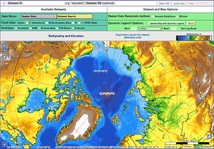Project Context
Arctic Ocean sea ice has been declining for several decades now. As the ice retreats, more open water is exposed. This reduces the amount of light reflected back from the Arctic and leads to further Arctic warming and sea ice loss. This particular phenomena contributes to the amplification of warming across Arctic regions, which is changing the regular connections between river water and atmospheric circulation, and consequently the heat and energy flowing into the Arctic Ocean.
Modern observations of Arctic river flow, and estimates of associated heat budgets, rarely extend back more than several decades. These records are too short and discontinuous to fully quantify the long-term trends in freshwater flow and heat budgets. This makes it difficult to understand the processes underlying those trends.
The TRISH project is designed to fill that gap by utilizing tree-ring records and river gauge data in the Arctic to reconstruct and study multi-century fluctuations of water, heat and energy flow to the Arctic Ocean.
We use a wide array of existing and newly collected tree-ring data from Siberia, coupled with a long record of river gauge data, to develop and test reconstructions of water flow and heat budgets for the Yenisei River, the second largest river of the Arctic.
Causal attribution of spatial-temporal variations of river hydrology requires consideration of changing snowmelt, thawing permafrost, and modification of natural flow regimes by dams and reservoirs. These considerations are addressed with the New Hampshire University Water Balance Model. By engaging with multiple layers of instrumental and modeled data updated to 2020 (e.g., climatic, hydrologic, anthropogenic, General Circulation Model (GCM) outputs) the team is using over 300 Siberian tree-ring records to reconstruct river discharge and water temperature for the last 300 years.

Old Data Exploration and Mapping
The University of New Hampshire hosts the project's open-access online tool.
StartHighlighted Activities
New tree-ring network in Khakassia and Tuva
As of now, the project has developed a network of precipitation-sensitive tree rings along the upper reaches of the Yenisei River. The new… More

